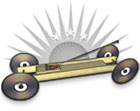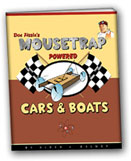Mousetrap Cars: Gearing
Gearing is what determines how far and how fast a mousetrap racer will travel. Learn how to matched the gearing of your vehicle to the correct type of challenge.
Gearing is how you control the acceleration, the pulling force, the torque, and the travel distance of your mousetrap vehicle. With mousetrap powered vehicles the gearing is always the combination of the lever arm length and the axle to wheel ratio. The most common design of a mousetrap car is to attach a string to a mouse trap's snapper and then to wind the string around a drive axle. As the string is pulled from the drive axle the mousetrap car is propelled by the turning of the drive wheels. It is the combination of the size of the wheels and the amount of string that is pulled from the drive axle that will determine how far the mousetrap vehicle is pulled by the force of the mouse trap. In most long-distance contest the objective is to propel a mousetrap car the longest possible linear distance. In this example the gearing will be set-up in such a way as to extend the mouse trap's energy over the longest possible distance. With most speed-trap contest the objective is to travel a set distance in the shortest amount of time possible. In this situation the gearing of the mousetrap racer will be set-up in such a way as to release all of the mouse trap's energy as fast as possible. The length of the mouse trap's lever arm and the drive axle to wheel ratio will all determine the gearing and the performance of your mousetrap vehicle.
Gearing is controlled by the following:
- the length of the lever arm
- the size of the drive wheel(s)
- the size of the drive axle
Lever Arm Basics
With most mousetrap cars the mouse trap's spring applies a torque to the mouse trap's snapper or lever arm; and then, the snapper arm applies a force to the drive axle through a string. A torque in it's simplest of terms is a perpendicular force applied some distance from the center of a rotating object. The total torque produced by a mouse trap's lever arm is always the same but the size of the force transferred by the string can be controlled by changing the length of this lever arm. With all changes to the length of the lever arm their are trade-offs, longer lever arms decrease the pulling force and decrease the power output but increase the amount of string that can be used or the pulling distance. Shorter lever arms increase the pulling force and increase the power output but decrease the amount of string that can be wound around the axle or the pulling distance. As a lever arm is made longer-and-longer the pulling force becomes smaller-and-smaller. If the lever arm is made to long, the pulling force of the lever arm will becomes so small that there will be not enough force to overcome the force of friction acting against the mousetrap vehicle's motion. The opposite is true with shorter lever arms. As a lever arm is cut shorter-and-shorter the pulling force becomes larger-and-larger. If the pulling force becomes to larger the drive wheels will spin in place at the start line. Adjusting the length of the lever arm becomes critical to the success of a mousetrap vehicle. There are two more elements that also need to be discussed, as mouse trap's spring releases it's energy the angle of the lever arm changes and so does the pulling force. The torque applied to the mouse trap's snapper arm decreases as the energy is released but in most cases the pulling force increase. This sounds strange at first but if you watch the string angle at the tip of the lever arm you will see that it's angle with the lever arm changes and this causes the force to increase.

bonus tip: the length of the lever arm determines the pulling force and the length of string that can be wrapped around the drive axle.

distance racers: long-distance racers will have longer lever arms to decrease the pulling force in order to conserve energy.

speed-trap racers: speed-trap racers will be geared to use a shorter lever arm in order to increase the pulling force and increase the acceleration.

strange but true: as the mouse trap releases it's energy the torque on the lever arm decreases but the force through the string increases as the angle between the string and lever arm changes.
Adjusting the Pulling Force
Changing the length of a mouse trap's snapper (or lever arm) is how you control a mouse trap vehicle's acceleration and/or travel distance. Different lengths of lever arms can be used to increase and/or decrease the pulling force and change the amount of string that can be pulled off the drive axle. Changing the length of the lever arm does not change the total energy and/or the torque produced by the mouse trap but it does change the pulling force applied to the drive axle. Longer lever arms will have less pulling force than shorter lever arm but longer lever arm will pull more string from the drive axle than shorter lever arm. Changing and/or attaching a lever arm to the mouse trap is the number one way to control a mousetrap vehicles performance.
Increase the Pulling Force
If a mousetrap vehicle is struggling to move or needs more acceleration then the lever arms can be shortened in order to increase the pulling force. Keep in mind that you will also have to reposition the mouse trap closer to the drive axle whenever you shorten the lever arm or the system will not work as intended.

bonus tip: a lever arm is cut using s dremal tool and a cutting wheel.
Decrease the Pulling Force
If a mousetrap car is spinning its wheels at the start or needs a longer pulling string a longer lever arms can be added to decrease the pulling force. Remember that when the length of the lever arm is changed the mouse trap will need to be repositioned on the chassis (see how to attach the mouse trap).

bonus tip: a longer lever arm is added by using couplers to attach two pieces of tubing together. If the lever arm is a 1/8 inch tubing than a 5/32 inch coupler can be used to join two pieces of tubing.

bonus tip: to find the correct position for the mouse trap, hold down the lever arm and line-up the mouse trap on the chassis.
Wheels and Axles
A transmission is any device that transmits mechanical energy from one point to another. With a mousetrap car the power is transferred to the wheels via a string wrapped around a drive axle. The ratio of the drive axle to the drive wheel represents the gearing of the vehicles or the transmission. By changing the size of the drive wheel(s) you can speed-up or slow-down your mousetrap vehicle. Larger drive wheels have a greater travel distance per each turn than smaller drive wheel. It would make sense to use a super huge drive wheel so for each turn of this massive wheel the mousetrap vehicle will travel an huge distance. But as the size of the drive wheel increase, more torque is required to keep the wheel turning. At some point a drive wheel can be so large that there is not enough force from the mouse trap to keep the drive wheel turning. With speed-trap racers smaller wheels will have a shorter travel distance per turn but will be much easier to accelerate and will require less pulling force to achieve the same acceleration as a larger wheel. Smaller drive wheels should be used on speed-trap racer in order to increase the acceleration and larger drive wheels should be used on long-distance travelers to cover more linear distance per rotation.
The diameter of the axle compared to the diameter of the wheel is also very important, the smaller the diameter of the axle in comparison to the diameter of the wheel the more force that will be required to accelerate the vehicle but the greater the distance of travel per rotation. This axle-to-wheel ratio is part of a mousetrap vehicle's gearing that needs to be understood in order to build the perfect racer for the contest at hand. For long distance racers a large diameter drive wheel with a small diameter drive axle is desired. For speed trap racers a smaller diameter drive wheel with a larger diameter drive axle is desired.
It is always important to understand the relationships between variables but never over exaggerate any one concept. The ideal size for an ultra big wheel on a long distance mousetrap racer seams to be somewhere between 10 and 15 inches. And the ideal size for a drive wheel on a speed-trap racer seams to be between 2 and 3 inches but no more than 4 inches.

bonus tip: speed-trap racers have a short lever arm, smaller diameter drive wheels, and a larger diameter drive axle in comparison to a long-distance racer.

bonus tip: long-distance racers have a longer lever arm, larger diameter drive wheels, and a smaller diameter drive axle in comparison to a speed-trap racer.
Adjusting the Gearing
If you place your mousetrap racer on the ground and the vehicle does not move or move very slowly and then comes to a stop then the problem is that your vehicle needs more torque or force at the drive wheels. If your mousetrap car does not have enough torque then you should increase the mechanical advantage of the system by doing one of the following.
Increase the torque by any of the following:
- shorten the length of the lever arm
- using a smaller diameter drive wheels, or
- increase the diameter of the drive axle
Tape Method
If you cannot change the lever arm length without a lot of reconstruction of your mousetrap vehicle then try increasing the diameter of the drive axle with tape. The idea here is to wrap tape around the drive axle and change the axle-to-wheel ratio and increase the torque delivered to the drive wheels.

step #1: Remove the original axle hook.

step #2: Starting in the center of the axle and carefully wind tape around the axle to build up the axle diameter.

step #3: Reattach the axle hook and then test the mousetrap racer. If more torque is still need after testing then add more tape as described above.

bonus tip: layers of tape can be removed to make a series of gears or a transmission on the axle so as to change the pulling force in steps.
*Can't find what you're looking for? Ask Doc Fizzix »




